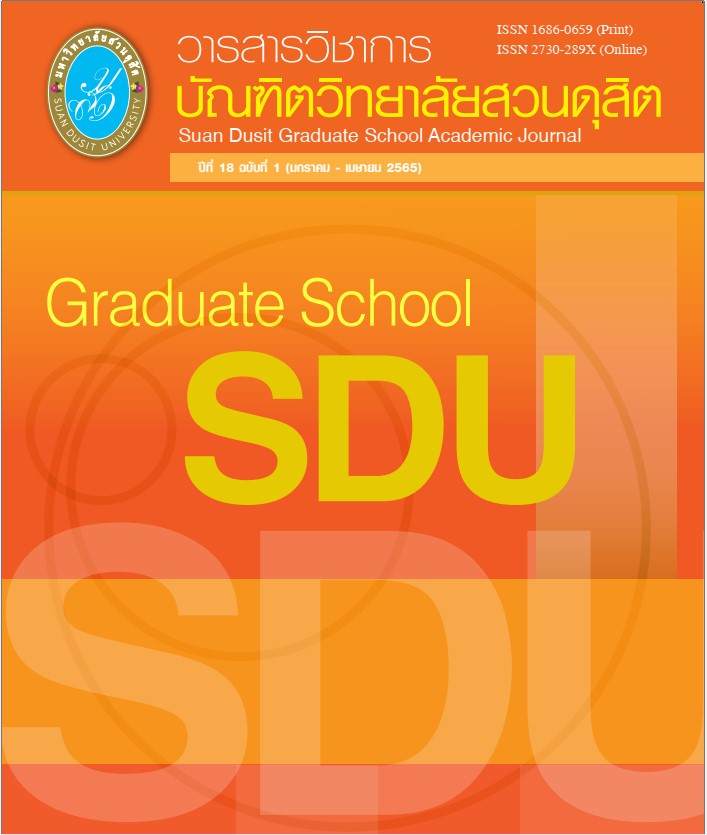Factors Affecting Marketing Strategy and Brand Building on Tutorial Application Acceptance of New Generation (Generation Z)
Abstract
The objective of this research was to identify the factors affecting marketing strategy and brand building on tutorial application acceptance of new generation (Generation Z). This research aimed to recommend the guidelines for tutorial institutes in establishing marketing strategy to use tutorial application with new generation (Generation Z). This research was quantitative research of which online questionnaire was the data collection tool with the sample group of secondary school students who were in Generation Z and attended tutorial school in Bangkok. The samples were selected by purposive sampling. The 430 completed questionnaires were obtained, and the descriptive and inferential statistics were used for examining the relationships between variables. The analysis results of Structural Equation Modeling indicated that Perceived Value affected User Satisfaction at 81% (R2=0.650) and User Satisfaction affected Loyalty at 98% (R2=0.646). In addition, the factors of Marketing Mix 4E’s and Technological Characteristics directly affected Perceived Value at 92% (R2=0.924). The factors of Marketing Mix 4E’s together with Generation Z Characteristics and Technological Characteristics affected Perceived Ease of Use at 79% (R2=0.797). Then, the researcher utilized the research findings to recommend the guidelines for promoting and developing the marketing strategies to achieve greater acceptance of the tutorial application.
References
เกียรติพงษ์ อุดมธนะธีระ. (2562). กลยุทธ์การตลาด 4Es และส่วนผสมทางการตลาด (Marketing Mix). [Online] Available: https://www.iok2u.com/index.php/article/marketing/330-4es-marketing-mix. [2564, กันยายน 20]
ธานินทร์ ศิลป์จารุ. (2560). การวิจัยและการวิเคราะห์ข้อมูลทางสถิติด้วย SPSS และ AMOS. กรุงเทพฯ: บิสซิเนสอาร์แอนด์ดี
อรพรรณ คงมาลัย และอัญณิฐา ดิษฐานนท์. (2561). เทคนิควิจัย ด้านการบริหารเทคโนโลยีและนวัตกรรม.กรุงเทพฯ: มหาวิทยาลัย ธรรมศาสตร
Electronic Transactions Development Agency. (2563). ETDA เผย ปี 62 คนไทยใช้อินเทอร์เน็ตเพิ่มขึ้นเฉลี่ย 10 ชั่วโมง 22 นาที Gen Y ครองแชมป์ 5 ปีซ้อน. [Online] Available: https://www.etda.or.th/th/NEWS/ETDA-Revealed-Thailand-Internet-User-Behavior-2019.aspx. [2564, กันยายน 20].
Aaker, D.A. (1991), Managing Brand Equity: Capitalizing on the Value of a Brand Name, New York: The Free Press. Journal of Business Research. 29 (3), 247-248.
Hartnett, M. (1998). Shopper Needs Must be Priority. Discount Store News. 37 (9), 21-22.
Hair, J.F., Hult, G.T.M., Ringle, C.M., Sarstedt, M. (2014). A Primer on Partial Least Squares Structural Equation Modeling (PLS-SEM). Sage, Thousand Oaks, CA.
Hu, L., Bentler, P. (1999). Cutoff criteria for fit indices in covariance structure analysis: Conventional criteria versus new alternatives. Structural Equation Modeling: A Multidisciplinary Journal. 6 (1), 1-55.
Ives, B., Oslon, M. H., & Baroudi, J. J. (1983). The measurement of user information satisfaction. Journal of Communications of the ACM. 26 (10), 785-793.
Jianguanglung D. (2016). Understanding The Generation Z: The Future Workforce. South-Asian Journal of Multidisciplinary Studies (SAJMS). 3 (3), 1-5.
Lindeman RH, Merenda PF, Gold RZ. (1980). Introduction to Bivariate and Multivariate Analysis. Scott, Foresman:Glenview, IL.
Lunneborg, C. E. (1979). Book Review: Psychometric Theory: Second Edition Jum C. Nunnally. New York: McGraw-Hill, 1978,701 pages. Applied Psychological Measurement. 3 (2), 279-280.
Schumacker, R. E. & Lomax, R. G., (2004). A beginner’s guide to structural equation modeling. New Jersey: Lawrence Erlbaum Associates.
Schiffman, L. G., & Kanuk, L. L. (1994). Consumer behaviour (5th ed.). New Jersey: Prentice-Hall.
Sheth N., Newman I., Gross L. (1991). Why We Buy What We Buy: A Theory of Consumption Values. Journal of Business Research. 22 (2), 159-170.
Teo, S.H.T., Lim, V.K.G. and Lai, R.Y.C. (1999). Intrinsic and extrinsic motivation in internet usage. Omega International Journal of Management Studies. 27, 25-37.
Yaser H. S., A. Shamsuddin. (2014). The Relationship between System Quality, Information Quality, and Organizational Performance. International Journal of Knowledge and Research in Management & E-Commerce. 4 (3), 7-10.
Downloads
Published
How to Cite
Issue
Section
License
Copyright (c) 2022 Graduate School, Suan Dusit University

This work is licensed under a Creative Commons Attribution-NonCommercial-NoDerivatives 4.0 International License.






